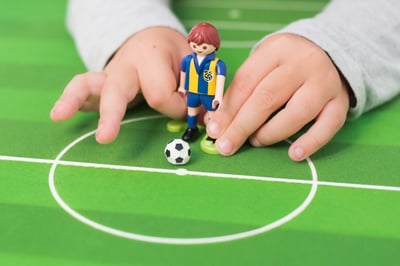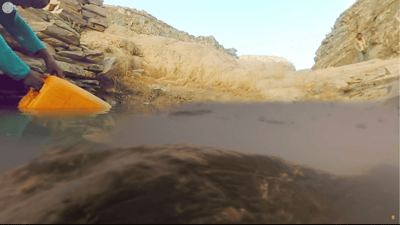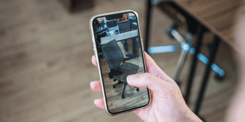We’ve previously talked about how you should approach designing in VR. But when you’re breaking a sweat to truly try to create this awesome visual experience, there are a host of factors to consider when using VR in your business presentations and trying to map out the VR reactions to the space. You’ll be looking at things like: what sounds are going to make them look a certain way, what visual cues are going to push them in a certain direction, deciding if there are items lying around that hint towards a next step or bring on an emotional cue, is the user going to be comfortable enough to keep the headset on? Every. Detail. Matters.
Today, we’re unpacking the specifics for your audience’s VR reactions. Understanding this will significantly improve your VR storytelling and design, and allow you to better tailor your VR content to have a closer connection to your target demographic! Our summary today is based on the learning we’ve done with our many hours of user testing and other research in the field. So, let’s dive in!
First things first…
First, let's get something out of the way; no, this blog isn't going to teach you how you can use ‘the force’ to magically engage with all of your users…(wouldn't that be cool though??!)

Everyone experiences things differently, and to be totally blunt, there is no way to precisely predict the VR reactions of every person on the face of the Earth when they put on a VR headset; it’s simply impossible. That’s why it’s really about finding ways to let people live and experience the story in their own time.
That being said, that doesn’t mean that there aren’t ways to make educated guesses based on proven scientific and statistical facts that work in your favour when it comes to designing for a specific demographic.
Let’s take a look at some of the biology behind VR Reactions
In a study done by a UCLA College Professor of physics, neurology, and neurobiology, Dr. Maynak Mehta found that “The pattern of activity in a brain region involved in spatial learning in the virtual world is completely different than when it processes activity in the real world.”
Makes sense - we all have a good understanding that when we’re immersed in VR, we have the knowledge that everything around us is virtual, regardless of how ‘real’ it looks.
Digging a little deeper - what makes the VR experience in your head is the hippocampus. This portion of the brain plays a crucial role when it comes to experiencing VR, but it’s actually more well-known for its involvement when it comes to diseases such as Alzheimer’s, stroke, and PTSD (post-traumatic stress disorder). The hippocampus helps your brain form new memories and create mental maps of space. So for example, when you put on a VR headset for the first time or you’re viewing a new VR experience, your hippocampal neurons become selectively active and start building a “cognitive map” of your surroundings. The neurons not only compose this map, but they even compute estimate distances based on ‘landmarks’ that you see in the space that stay in your memories. Remember, they’re just estimates.
 How else do you think you remember how big that fish was that you caught that one time?? (FYI… the fish wasn't that big)
How else do you think you remember how big that fish was that you caught that one time?? (FYI… the fish wasn't that big)How else do you think your uncle remembers how big that fish was that he caught that one time? Don’t worry… he’s either exaggerating a bit or his spatial memory in his hippocampus is slightly off.
Scientists measured the neural activity in the brains of rats when they were exploring real spaces versus virtual spaces that were designed to be a reflection of the real space, and the results concluded that the rats had LESS THAN HALF of the neural activity from the virtual world in comparison to the real world.
So, what does this have to do with predicting human interaction with spaces?
Well, now we understand that there is no comparison, microscopically, to the real world and that people will always be able to subconsciously know when they’re in a virtual environment as opposed to being in a real space because the neurons in your brain just aren't as active when they’re looking at something virtual. Nonetheless, as you may have seen before, VR experiences can get pretty close to the real deal, which is one of the huge selling points behind it. In fact, VR content is commonly produced by 360 cameras of real space as opposed to renderings, which is why VR is so great for industries like travel and real estate. You get that near-real experience that you just can’t get from anything else, which is why things like VR roller coasters are such a thrill (even if you look like a dork who’s about to fall out of a chair in the middle of your kitchen - it’s FUN). The visceral virtual reality reactions videos you’ll find on YouTube, of people jumping and screaming point to just how real the emotions are, even when the space isn’t real.
The first glance in VR
Here at Yulio, based on over 1000 hours of user testing, we’ve learned that the majority of people will look up and to the right when they enter VR.
Now, don’t fret - it makes a lot of sense. Consider that only about 10% of the world’s population are left-handed, meanwhile the remaining 90% are right-handed, so based on which hand or side is more dominant for the user, i.e. more comfortable for you to turn towards, will determine which way they look - (of course, this is assuming that there are no other distractions that interrupt the natural navigation when they first enter your experience).
Next, because you’re in VR, your first instinct is to break the barrier for yourself and explore your environment. A lot of people when they’re looking around in virtual reality forget that they can look directly above, below and behind them; therefore, their first instinct will be to aim their eyes at where the seam of a screen would typically lie and push past it. So continuing with the direction they look based on their dominant hand/side, the user will continue this motion and look beyond a point that a typical 2D medium would cut off. We use common sense to understand that if we look down, we’ll most likely see the ground, so this is why the natural instinct is to look upwards.. we don't usually expect to see a ceiling depending on the experience; the sky’s the limit! Plus, anything is better than staring at the floor.
With these two natural instincts combined, we can come to the conclusion that the first move for the user (based on the statistical majority of users) will be up and to the right.
*Keep in mind that this is only true if the virtual environment they’re immersed in is distraction free... If there is a monkey on a unicycle blowing a french horn to the left of the user, then obviously the user is going to change their scope of navigation to look at the monkey.. We’re only human, and who could resist looking if that WAS the case.
Now that we have a general idea of where (the majority of) our users are going to be looking, we can delve right into how our audiences consume VR.
What’s the natural reaction for kids?
When kids play, their imagination takes over. That one box that was thrown into the corner is now a time machine that’s also a fancy sports car. Kids have this stunning ability to entertain themselves, while also blocking out the rest of the world. In their minds, this time machine/car is the only thing existing when they play. Now, bring this same child into VR and they’re going to be astonished by the immersive experience. Research suggests that since kids have such active and imaginative minds, that they’re able to believe in the VR content in front of them as if it’s actually happening, and they’re able to ‘fill in the gaps’ where VR content may be less believable.

Next, kids respond to adrenalistic moments MUCH MORE than adults do. In fact, studies show that adults learn the ability to control their emotions to an extent using a ‘self-reserved’ technique. For instance, think of a time where you were watching a scary movie - this technique, where you’re trying not to flinch or react when there’s a scary pop-out coming is a variation of this. It gives you some breathing room or some ‘distance’ between yourself and the experience in front of you. Kids simply haven't had enough experience in their lifetime to distance themselves from what’s in front of them, and at this age, being as curious and imaginative as they are, they probably wouldn't want to!
If you want to make a lasting impact and your primary audience is largely kids then you’re looking to add some imagination and adrenaline to your experience! Kids minds run 1000 miles a minute and are still very much floating in the clouds when it comes to playing - so you want to base some of your design around events that are ‘out-of-this-world’, adventurous, and full of life. Even leading them on hunts with obvious next steps might be ideal for them. Think about beloved adventure TV shows like Dora the Explorer. The fun of the show is that the kids can follow along and yell about Dora’s next step based on what they see and what kind of a situation Dora falls into. For example, if kids see Swiper the Fox on the screen, the kids know to yell that he's there and, “Swiper, no swiping!”. Or if Dora needs to find out which way she's going, and they open her backpack, they’ll know to reach for the map.
Simple concepts and exciting experiences can go a long way with kids, so grasp your adventure concept, keep it simple and straightforward, and you’re on track to impressing the youngins.
Does gender affect how you consume VR?
Yes! Generally, males and females consumer VR differently!
 Everyone experiences VR content differently, but science proves that there are general trends that are different between men and women.
Everyone experiences VR content differently, but science proves that there are general trends that are different between men and women.
Now, obviously this research can’t speak for every individual out there because it will vary based on the person and a hundred other factors in the mix, but this is what studies found generally:
Women are more emotionally connected to VR content
A few studies suggest that females (on average) experience a greater level of presence in VR. One of the explanations suggests that because females empathize more easily than men, so they’re more likely to connect to the content. Therefore, they have more immersive and connected virtual reality reactions in comparison, and this is true for empathizing toward both real people and virtual figures. VR is well-known for tapping into the emotions of users, which is why it’s such a thrilling medium; you just can’t get the same emotional experience when you’re watching a video of a roller coaster on your laptop versus watching it in a VR headset. The emotional connection that people experience while immersed in VR is a huge factor in how ‘convincing’ the experience is for them. In fact, studies show that VR delivers a 27% higher emotional engagement and 34% longer engagement than 2D content, and with graphic or emotional content, we can obviously assume that the statistics much higher than just 27%.
Charities and nonprofits find good success leveraging VR reactions when it comes to raising awareness and funds for their causes. Take for instance, Charity: Water, who arranged a black-tie gala to show a VR movie which took place in a small village in Ethiopia, and followed the story of a girl and her family and their day-to-day lives, including their long travels to get water - and not clean water by any means.

The state of the water alone is a shock factor, but you also see the state of the family’s home, their school conditions and what their daily chores are, which are vastly different than what we experience here. The film ends with a truck full of workers installing a clean water well, and the impact and enthusiasm that was brought to this community, and how much this will change these individuals lives. Because of the strong VR reactions, this gala raised over 2.4 million dollars in donations by the end of the evening which exceeded beyond the organization's expectations.
This just goes to show that VR’s ability to engage the emotions of users is incredible and can have a huge impact when it comes to events such as these.
If you’re designing for an experience that has a target audience of mostly women, then adding aspects where women may be more emotionally vulnerable could make a more hooking experience. Keep your audience on the edge!
Men enjoy mapping out virtual spaces
Another difference between genders when it comes to experiencing VR content is spatial reasoning skills! According to researchers, men (on average) have better spatial skills than women, so they’re better able to digest a 3D virtual environment in their head as opposed to women, and apparently, they actually enjoy mentally mapping VR too! This means that if you throw a man and a woman into a complex space, then take them out of it - the man (on average) should have a better memory of the space as opposed to the woman.
Men are big for strategy games - even look at the user-base for games such as Civilization. Men like to seek and conquer, so when it comes to learning spaces and strategizing the next move - men are all for it. If your audience base is primarily men, then keep them on their toes and give them room to learn, explore, then strategize how they’re going to keep moving forward.
Everything in-between
Veering away from the differences between genders, now we’re going to look at the more general factors that can have an impact for how well an individual reacts to a virtual experience.
Cognition is a factor in experiencing VR!
Things like general intelligence and attention span have huge impacts on how well someone perceives a virtual experience and the specifics of their VR reactions. According to research, people who are have higher attention levels have a better capacity to focus on the virtual world and are better able at ‘shutting off’ the real world. This increased level of focus lets them experience their virtual environment in the moment, which leads to a more immersed and engaged VR experience.
Based on your personality, you may have drastically different experiences than others
There are a bunch of personality traits that could determine whether or not VR is suitable for you. For instance, if you’ve ever gone to see a magician and you’ve volunteered to be hypnotized, then VR is most likely thrilling for that individual; however, in a scenario where the individual is chosen from a crowd and is unable to be hypnotized says a different story... Just like how some people take a bit more time to be comfortable (maybe if they’re more prone to nervous or anxious behaviour) in certain scenarios follows the same general premise for whether or not they’ll enjoy being immersed in VR. The more willing a person is to give in to an experience, the better reaction they’ll ultimately have to the content in front of them. This is also true for introverts as opposed to extroverts; the more willing a person is to participate in the experience and suspend any sort of disbelief in their mindset, the greater the immersion and overall feeling of presence they’ll have when they’re in VR and the stronger their VR reactions will be.
Keep in mind that the research beyond VR and user experiences is still pretty new, (and consumers are turtles when it comes to worldwide-adoption) so with time we’ll have a better grasp on how people react to a lot more virtual situations, but for the time being, this is a pretty good start. This information does, however, help us understand the difference in designing for certain audiences, which includes people who don’t feel quite as immersed as others when they put on their VR headset for the first time.
Just getting started with virtual reality and want a hand getting things off the ground? We run a free introductory training webinar every other Thursday at 1 PM EST by our Client Success Manager to teach you everything there is to know about Yulio’s functions, features, and the nitty-gritty tips to help you effortlessly become successful with Yulio! Grab your seat here. Still looking into VR solutions? We’ve got a 30-day free trial with full access to all of Yulio’s fabulous features to give you a true taste of our product and how easy is it to start showing your designs in stunning virtual reality. Sign up for your free account here!



.jpg?width=245&height=150&name=active-adult-beautiful-1799244%20(1).jpg)

